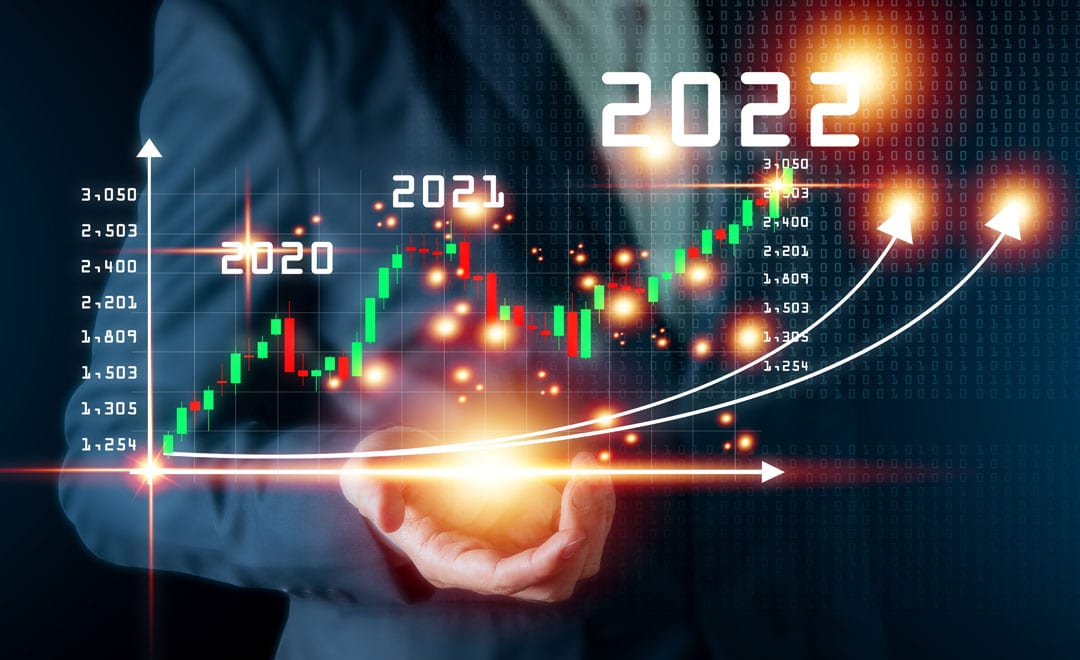Happy 2022 from Henssler Financial! With above-average 2021 financial market performance in our rear view, we look to the future as several topics are in focus for the new year.
Much has been made of inflation and the Federal Reserve’s heightened attention to this issue in recent weeks. Inflation, measured by the U.S. Census Bureau’s Consumer Price Index (CPI), rose to its highest level since 1982 in December 2021, increasing 7%. Early in December, the U.S. Federal Reserve made it clear they no longer considered inflation a temporary phenomenon and stepped up their messaging to include a planned tapering of bond purchases to be completed by the end of March 2022. They expect to raise the overnight lending rate three times by year-end 2022.
Market interest rates have risen on this news. Growth companies, those expected to grow revenues by an above-average margin, have languished in the weeks following that message. With overall market valuations well above their longer-term averages at the beginning of the year and rates expected to rise, we believe this provides a significant headwind to market price growth in 2022. However, this is not the first time you have heard this warning from us, as we made similar statements concerning valuations in early 2021 minus the confidence of rising rates. This year feels a bit different as inflation is forcing the action on interest rates. To balance higher prices, we believe earnings growth is likely to continue. Companies are enjoying high consumer demand as the recovery from the COVID pandemic recession continues. Fueling inflation is this demand combined with supply chain issues that have made goods a bit too scarce. The common economic reaction to such a scenario is higher prices.
Put more directly, we believe the investment benefits from higher earnings will likely be offset by higher interest rates, thus forming our expectations of below-average returns in financial assets in 2022. If you recall, the long-term average annual return for the market benchmark S&P 500 is approximately 10.5% over the past century. We expect positive returns in the year ahead but well below this average. We also believe a conservative approach in portfolio management is warranted with a tilt toward value investments and a slight underweight to growth companies, which have been dominant for the past decade.
Higher interest rates more directly impact bond prices. Long-term bonds suffered a loss of 2.5% in 2021 as measured by the Bloomberg U.S. Government/Credit Bond Index. The index includes investment grade corporate, Treasury, and government-related bonds with a 10-year maturity. While losses are not uncommon in the index, consecutive annual losses are. The last time consecutive losses were experienced was from 1978 to 1980, when interest rates increased approximately 84% from below 8% to above 14%. Short-term bonds also suffered a loss, the first such loss since the inception of the Bloomberg 1-3 Year Government/Credit Index dating to 1976. The small yields at the beginning of 2020 on the 1-3 Year Government bond increased from 0.16% to more than 0.95% during 2021—a move sufficient to drive the index to a 0.47% loss.
We expect similar directional movement in bond yields in 2022; however, we believe short-term bonds are likely to gain slightly in the coming 12 months, but the long-term bond may suffer another loss. Having enjoyed a 30-year benefit from continuously declining yields, we believe we have reached the end of the bull market in bonds. The fight against inflation is likely to make bond returns less reliable in the next few years. Keeping maturities short and searching for additional strategies to bolster returns while avoiding bond price volatility is likely to become a bigger task.
Several other factors are likely to complicate our domestic economic environment in 2022, including the Build Back Better bill proposed by President Biden and backed by most Congressional Democrats. The roadblock to Senate passage has been Joe Manchin, who balked at the price tag. We believe the passing of such a large spending bill and the higher taxes necessary to fund it would be negatives for our economy. As noted earlier, consumer demand is high as much of the money distributed during the pandemic rescue has been saved. Additional government spending on climate change, health care, universal pre-kindergarten, and child tax credits would likely add fuel to the inflation fire. While we believed it was likely to pass by the end of 2021, it is now anybody’s guess whether it will pass in its current form. To make it more interesting, 2022 is an election year, and most political analysts expect Republicans to pick up many seats in the House of Representatives and a few in the Senate. If the balance of power changes giving the Republican Party control, it would likely kill any chances of Build Back Better passing, if it doesn’t pass soon. We are watching the political scene closely but don’t expect it to have a major impact on financial markets this year.
If you have questions or need assistance, contact the Experts at Henssler Financial:
- Experts Request Form
- Email: experts@henssler.com
- Phone: 770-429-9166








